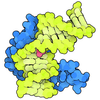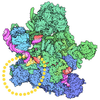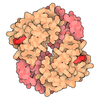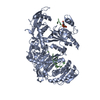[English] 日本語
 Yorodumi
Yorodumi- EMDB-49409: Cryo-EM structure of SIWI-piRNA-target(49-nt)-GTSF1-Maelstrom com... -
+ Open data
Open data
- Basic information
Basic information
| Entry |  | |||||||||
|---|---|---|---|---|---|---|---|---|---|---|
| Title | Cryo-EM structure of SIWI-piRNA-target(49-nt)-GTSF1-Maelstrom complex (conformation 2) | |||||||||
 Map data Map data | ||||||||||
 Sample Sample |
| |||||||||
 Keywords Keywords | SIWI / GTSF1 / Maelstrom / RNA BINDING PROTEIN / RNA BINDING PROTEIN-RNA complex | |||||||||
| Function / homology |  Function and homology information Function and homology informationfemale sex determination / regulation of miRNA-mediated gene silencing / PET complex / secondary piRNA processing / piRNA binding / piRNA-mediated gene silencing by mRNA destabilization / piRNA processing / male meiotic nuclear division / P granule / Hydrolases; Acting on ester bonds; Endoribonucleases producing 5'-phosphomonoesters ...female sex determination / regulation of miRNA-mediated gene silencing / PET complex / secondary piRNA processing / piRNA binding / piRNA-mediated gene silencing by mRNA destabilization / piRNA processing / male meiotic nuclear division / P granule / Hydrolases; Acting on ester bonds; Endoribonucleases producing 5'-phosphomonoesters / RNA endonuclease activity / meiotic cell cycle / spermatogenesis / sequence-specific DNA binding / cell differentiation / negative regulation of DNA-templated transcription / magnesium ion binding / metal ion binding / nucleus / cytoplasm Similarity search - Function | |||||||||
| Biological species |  | |||||||||
| Method | single particle reconstruction / cryo EM / Resolution: 4.1 Å | |||||||||
 Authors Authors | Sarkar S / Gebert LFR / MacRae IJ | |||||||||
| Funding support |  United States, 1 items United States, 1 items
| |||||||||
 Citation Citation |  Journal: Mol Cell / Year: 2025 Journal: Mol Cell / Year: 2025Title: A conserved PIWI silencing complex detects piRNA-target engagement. Authors: Dipayan De / Sucharita Sarkar / Luca F R Gebert / Timothy Wiryaman / Todd A Anzelon / Ian J MacRae /  Abstract: In animal germ cells, PIWI proteins use piRNAs to detect active selfish genetic elements. Base-pairing to a piRNA defines transposon recognition, but how this interaction triggers a defensive ...In animal germ cells, PIWI proteins use piRNAs to detect active selfish genetic elements. Base-pairing to a piRNA defines transposon recognition, but how this interaction triggers a defensive response remains unclear. Here, we identify a transposon recognition complex composed of the silkworm proteins Siwi, GTSF1, and Maelstrom. Biochemical and cryo-electron microscopy (cryo-EM) analyses show that extended piRNA-target pairing locks Siwi in a conformation that recruits GTSF1 and Maelstrom. Extended piRNA-target pairing is recognized by the N-terminal helix of Maelstrom and the first zinc finger of GTSF1, which act together to hold Siwi in an endonucleolytically active state. The resulting activated complex, termed Siwi, rapidly cleaves target RNAs and recruits the piRNA biogenesis factor Spindle-E. Structural predictions reveal related complexes in animals ranging from humans to sponges, indicating PIWI assembly is a conserved transposon recognition mechanism employed broadly across the metazoan kingdom. | |||||||||
| History |
|
- Structure visualization
Structure visualization
| Supplemental images |
|---|
- Downloads & links
Downloads & links
-EMDB archive
| Map data |  emd_49409.map.gz emd_49409.map.gz | 97.9 MB |  EMDB map data format EMDB map data format | |
|---|---|---|---|---|
| Header (meta data) |  emd-49409-v30.xml emd-49409-v30.xml emd-49409.xml emd-49409.xml | 25.2 KB 25.2 KB | Display Display |  EMDB header EMDB header |
| Images |  emd_49409.png emd_49409.png | 44.3 KB | ||
| Filedesc metadata |  emd-49409.cif.gz emd-49409.cif.gz | 7.9 KB | ||
| Others |  emd_49409_half_map_1.map.gz emd_49409_half_map_1.map.gz emd_49409_half_map_2.map.gz emd_49409_half_map_2.map.gz | 73.2 MB 73.2 MB | ||
| Archive directory |  http://ftp.pdbj.org/pub/emdb/structures/EMD-49409 http://ftp.pdbj.org/pub/emdb/structures/EMD-49409 ftp://ftp.pdbj.org/pub/emdb/structures/EMD-49409 ftp://ftp.pdbj.org/pub/emdb/structures/EMD-49409 | HTTPS FTP |
-Validation report
| Summary document |  emd_49409_validation.pdf.gz emd_49409_validation.pdf.gz | 908 KB | Display |  EMDB validaton report EMDB validaton report |
|---|---|---|---|---|
| Full document |  emd_49409_full_validation.pdf.gz emd_49409_full_validation.pdf.gz | 907.5 KB | Display | |
| Data in XML |  emd_49409_validation.xml.gz emd_49409_validation.xml.gz | 13.3 KB | Display | |
| Data in CIF |  emd_49409_validation.cif.gz emd_49409_validation.cif.gz | 15.9 KB | Display | |
| Arichive directory |  https://ftp.pdbj.org/pub/emdb/validation_reports/EMD-49409 https://ftp.pdbj.org/pub/emdb/validation_reports/EMD-49409 ftp://ftp.pdbj.org/pub/emdb/validation_reports/EMD-49409 ftp://ftp.pdbj.org/pub/emdb/validation_reports/EMD-49409 | HTTPS FTP |
-Related structure data
| Related structure data |  9nhdMC  9nhbC  9nhcC  9nheC  9nhsC M: atomic model generated by this map C: citing same article ( |
|---|---|
| Similar structure data | Similarity search - Function & homology  F&H Search F&H Search |
- Links
Links
| EMDB pages |  EMDB (EBI/PDBe) / EMDB (EBI/PDBe) /  EMDataResource EMDataResource |
|---|---|
| Related items in Molecule of the Month |
- Map
Map
| File |  Download / File: emd_49409.map.gz / Format: CCP4 / Size: 103 MB / Type: IMAGE STORED AS FLOATING POINT NUMBER (4 BYTES) Download / File: emd_49409.map.gz / Format: CCP4 / Size: 103 MB / Type: IMAGE STORED AS FLOATING POINT NUMBER (4 BYTES) | ||||||||||||||||||||||||||||||||||||
|---|---|---|---|---|---|---|---|---|---|---|---|---|---|---|---|---|---|---|---|---|---|---|---|---|---|---|---|---|---|---|---|---|---|---|---|---|---|
| Projections & slices | Image control
Images are generated by Spider. | ||||||||||||||||||||||||||||||||||||
| Voxel size | X=Y=Z: 0.91 Å | ||||||||||||||||||||||||||||||||||||
| Density |
| ||||||||||||||||||||||||||||||||||||
| Symmetry | Space group: 1 | ||||||||||||||||||||||||||||||||||||
| Details | EMDB XML:
|
-Supplemental data
-Half map: #2
| File | emd_49409_half_map_1.map | ||||||||||||
|---|---|---|---|---|---|---|---|---|---|---|---|---|---|
| Projections & Slices |
| ||||||||||||
| Density Histograms |
-Half map: #1
| File | emd_49409_half_map_2.map | ||||||||||||
|---|---|---|---|---|---|---|---|---|---|---|---|---|---|
| Projections & Slices |
| ||||||||||||
| Density Histograms |
- Sample components
Sample components
-Entire : SIWI-piRNA-target(49-nt)-GTSF1-Maelstrom complex (conformation 2)
| Entire | Name: SIWI-piRNA-target(49-nt)-GTSF1-Maelstrom complex (conformation 2) |
|---|---|
| Components |
|
-Supramolecule #1: SIWI-piRNA-target(49-nt)-GTSF1-Maelstrom complex (conformation 2)
| Supramolecule | Name: SIWI-piRNA-target(49-nt)-GTSF1-Maelstrom complex (conformation 2) type: complex / ID: 1 / Parent: 0 / Macromolecule list: #1-#5 |
|---|---|
| Source (natural) | Organism:  |
-Macromolecule #1: Piwi-like protein Siwi
| Macromolecule | Name: Piwi-like protein Siwi / type: protein_or_peptide / ID: 1 / Number of copies: 1 / Enantiomer: LEVO EC number: Hydrolases; Acting on ester bonds; Endoribonucleases producing 5'-phosphomonoesters |
|---|---|
| Source (natural) | Organism:  |
| Molecular weight | Theoretical: 101.484242 KDa |
| Recombinant expression | Organism:  |
| Sequence | String: MSEPRGRGRA RGRAGRGGDG GGPAPRRPGE QAGPSQQSMP PGPRPQPPSG WGPQSSVPPV RAGVPTPTAQ AGRASHRVTP TTHEHPGDI DVQQRMQKLE LGPHSSGGGD ASSVVGRGSR RGGGRVLPET ISILRTRPEA VTSKKGTSGT PLDLLANYFT V ETTPKWGL ...String: MSEPRGRGRA RGRAGRGGDG GGPAPRRPGE QAGPSQQSMP PGPRPQPPSG WGPQSSVPPV RAGVPTPTAQ AGRASHRVTP TTHEHPGDI DVQQRMQKLE LGPHSSGGGD ASSVVGRGSR RGGGRVLPET ISILRTRPEA VTSKKGTSGT PLDLLANYFT V ETTPKWGL YQYHVDISPE EDSTGVRKAL MRVHSKTLGG YLFDGTVLYT VNRLHPDPME LYSDRKTDNE RMRILIKLTC EV SPGDYHY IQIFNIIIRK CFNLLKLQLM GRDYFDPEAK IDIPEFKLQI WPGYKTTINQ YEDRLLLVTE IAHKVLRMDT VLQ MLSEYA ATKGNNYKKI FLEDVVGKIV MTDYNKRTYR VDDVAWNVSP KSTFKMRDEN ITYIEYYYKK YNLRIQDPGQ PLLI SRSKP REIRAGLPEL IYLVPELCRQ TGLSDEMRAN FKLMRSLDVH TKIGPDKRIE KLNNFNRRFT STPEVVEELA TWSLK LSKE LVKIKGRQLP PENIIQANNV KYPAGDTTEG WTRDMRSKHL LAIAQLNSWV VITPERQRRD TESFIDLIIK TGGGVG FRM RSPDLVVIRH DGPIEYANMC EEVIARKNPA LILCVLARNY ADRYEAIKKK CTVDRAVPTQ VVCARNMSSK SAMSIAT KV AIQINCKLGG SPWTVDIPLP SLMVVGYDVC HDTRSKEKSF GAFVATLDKQ MTQYYSIVNA HTSGEELSSH MGFNIASA V KKFREKNGTY PARIFIYRDG VGDGQIPYVH SHEVAEIKKK LAEIYAGVEI KLAFIIVSKR INTRIFVQRG RSGENPRPG TVIDDVVTLP ERYDFYLVSQ NVREGTIAPT SYNVIEDTTG LNPDRIQRLT YKLTHLYFNC SSQVRVPSVC QYAHKLAFLA ANSLHNQPH YSLNETLYFL UniProtKB: Piwi-like protein Siwi |
-Macromolecule #4: GTSF1
| Macromolecule | Name: GTSF1 / type: protein_or_peptide / ID: 4 / Number of copies: 1 / Enantiomer: LEVO |
|---|---|
| Source (natural) | Organism:  |
| Molecular weight | Theoretical: 17.358834 KDa |
| Recombinant expression | Organism:  |
| Sequence | String: MEVTIANPKP NQMITCPYEK AHIVEHYRMH IHLQKCRKQH PACNKVQCPF DATHVVNDVE LDFHVTVCPK RHMLDTQLYI TDDEYRPTV EVHATPVLPS DENWDDETST SYIPDPSKKG AHIITKAKGL TRSERQSLRK ELIKTYRPLE UniProtKB: CHHC U11-48K-type domain-containing protein |
-Macromolecule #5: Maelstrom
| Macromolecule | Name: Maelstrom / type: protein_or_peptide / ID: 5 / Number of copies: 1 / Enantiomer: LEVO |
|---|---|
| Source (natural) | Organism:  |
| Molecular weight | Theoretical: 49.900469 KDa |
| Recombinant expression | Organism:  |
| Sequence | String: MPKKKTPQNP FFFFMMDYRK EQAEIGIKYA NTKELAEAAG PVWQNLRPTL KAKYEEKAKN EKEKNKQTGT KFTSTGIPIK VIEQQQREM KNAEDNEKKD IQNIVKLKVF DQSIKTEDFY VIDVNSYCKA NGDYLIGEFT VTQFSLQDGV KNSYHETIIP S CVPVGYMF ...String: MPKKKTPQNP FFFFMMDYRK EQAEIGIKYA NTKELAEAAG PVWQNLRPTL KAKYEEKAKN EKEKNKQTGT KFTSTGIPIK VIEQQQREM KNAEDNEKKD IQNIVKLKVF DQSIKTEDFY VIDVNSYCKA NGDYLIGEFT VTQFSLQDGV KNSYHETIIP S CVPVGYMF DVKLGAEEFG LEMPGTDDAG PNYIQILANI IDYLKQKDRT VQVLPPMFTL PEKVDAVQNF ISQMCNCATE DD SLFRIYK LDTFFFTLIN AISSHHDEGF PKESLALTQL TKDLFDYTPG IACERHESLD RSNVCTTSRV KRWVFTILDR CCP LLGIPL QPGKHLPFDY DINGILIFKE ERKTRAAPSV PRTATASSNS SFINDSLNES FQSLNVTGET AASGSAPGRR VHKP LRMPR TDYSQRIQQA PELTEANFPT LTGHGRGRGL TRSNN UniProtKB: HMG box domain-containing protein |
-Macromolecule #2: piRNA
| Macromolecule | Name: piRNA / type: rna / ID: 2 / Number of copies: 1 |
|---|---|
| Source (natural) | Organism: synthetic construct (others) |
| Molecular weight | Theoretical: 8.111833 KDa |
| Sequence | String: UGGAGUGUGA CAAUGGUGUU UGAU(A2M) |
-Macromolecule #3: target RNA (49-nt)
| Macromolecule | Name: target RNA (49-nt) / type: rna / ID: 3 / Number of copies: 1 |
|---|---|
| Source (natural) | Organism: synthetic construct (others) |
| Molecular weight | Theoretical: 15.603524 KDa |
| Sequence | String: AAAAAAAUAU CAAACACCAU UGUCACACUC CAAAAAAAAC CCCAAAACC |
-Macromolecule #6: MAGNESIUM ION
| Macromolecule | Name: MAGNESIUM ION / type: ligand / ID: 6 / Number of copies: 1 / Formula: MG |
|---|---|
| Molecular weight | Theoretical: 24.305 Da |
-Experimental details
-Structure determination
| Method | cryo EM |
|---|---|
 Processing Processing | single particle reconstruction |
| Aggregation state | particle |
- Sample preparation
Sample preparation
| Concentration | 0.86 mg/mL | ||||||||||||
|---|---|---|---|---|---|---|---|---|---|---|---|---|---|
| Buffer | pH: 8 Component:
| ||||||||||||
| Grid | Model: UltrAuFoil R1.2/1.3 / Material: GOLD / Mesh: 300 / Pretreatment - Type: GLOW DISCHARGE / Pretreatment - Time: 25 sec. / Pretreatment - Atmosphere: AIR / Pretreatment - Pressure: 0.026000000000000002 kPa / Details: 15 mA | ||||||||||||
| Vitrification | Cryogen name: ETHANE / Chamber humidity: 100 % / Chamber temperature: 277.15 K / Instrument: FEI VITROBOT MARK IV |
- Electron microscopy
Electron microscopy
| Microscope | FEI TALOS ARCTICA |
|---|---|
| Image recording | Film or detector model: GATAN K2 SUMMIT (4k x 4k) / Number real images: 4802 / Average electron dose: 50.0 e/Å2 |
| Electron beam | Acceleration voltage: 200 kV / Electron source:  FIELD EMISSION GUN FIELD EMISSION GUN |
| Electron optics | Illumination mode: OTHER / Imaging mode: BRIGHT FIELD / Nominal defocus max: 3.0 µm / Nominal defocus min: 1.0 µm |
| Sample stage | Specimen holder model: FEI TITAN KRIOS AUTOGRID HOLDER |
| Experimental equipment |  Model: Talos Arctica / Image courtesy: FEI Company |
+ Image processing
Image processing
-Atomic model buiding 1
| Initial model |
| ||||||||
|---|---|---|---|---|---|---|---|---|---|
| Refinement | Space: REAL / Protocol: FLEXIBLE FIT | ||||||||
| Output model |  PDB-9nhd: |
 Movie
Movie Controller
Controller














 Z (Sec.)
Z (Sec.) Y (Row.)
Y (Row.) X (Col.)
X (Col.)





































